| |
|
 | |
| MaltaWildPlants.com by Stephen Mifsud |

|
| |
|
|
 |  |  |  |
| External Links: |
|
Ranunculus bullatus (Autumn Buttercup) |
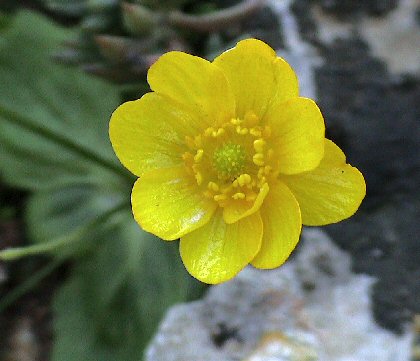
Ranunculus bullatus (RANUNCULACEAE.)
Images for this profile are taken from the Maltese Islands after year 2000. |
|
| Nomenclature |
Species name : | Ranunculus bullatus L. | Authority : | Carl von Linne, Sweden, (1707 - 1778) | Synonyms :
(basionym or principal syn.) |
|
Plant Family : | | English name(s) : | Autumn Buttercup, Bullate Buttercup, Golden Button | Maltese name(s) : | Ċfolloq tal-ħarifa | Status for Malta : | Indigenous. Present on the Maltese islands before man | Name Derivation : |
Ranunculus: from rana which means a small frog given because many species tend to grow in moist, wet or marshy places where frogs are found. (Latin origin ); 2 = from rana, "little frog" because many species tend to grow in moist / marshy places where frogs are usually found. (Latin);.
bullatus: Having an inflated, blistered or puckered structure or texture, with reference to the leaves with bulging areas. (Latin origin ); 2 = Having an inflated, blistered or puckered structure or texture with reference to the leaves. (Latin).
| Remarks : | |
|
| Morphology and structure |
PLANT STRUCTURE: |
Character | Growth Form | Branching | Surface |
Description | | | |
General
Picture |  |  | 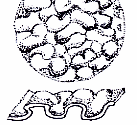 |
|
LEAVES: |
Character | Arrangement | Attachment | Venation |
Description | | | |
General
Picture | 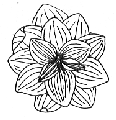 | 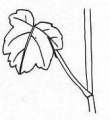 |  |
| |
Character | Leaf Shape | Leaf Margin | Remarks |
Description | | | |
General
Picture |  | 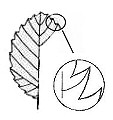 |  |
|
FLOWERS: |
Character | Colour | Basic Flower Type | No. of Petals | No. of Sepals |
Description | Shining Yellow | | 5-10 (5 petals is the most common). | 5 |
General
Picture | | 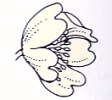 |  |  |
| |
Character | Inflorescence | Description | Ovary | Stamens |
Description | | The actinomorphic flower consists of 5 to 10 shiny yellow petals and 5 green-yellow bucket shaped sepals. At the centre there is the receptacle bearing above numerous, green ovaries with small projecting style+stigma. The stigma tips are sometimes yellow with entrapped pollen. A cluster of stamens lies around the receptacle+ovaries structure. | | |
General
Picture |  |  | 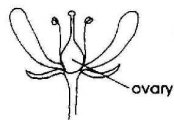 |  |
| |
Character | Scent | Average Flower Size | Pollen Colour | Other Notes |
Description | YES Little sweet scent which maybe missed in the open air. | 20-25mm | Yellow | - |
|
SEEDS: |
Character | No. Per Fruit | Shape | Size | Colour |
Description | 40-100 | Ovoid Oval (tooth shaped) achene with an eccentric rod-like projecting structure. | 1-2 mm | Green to light brown Achenes often fall off unripe. |
General
Picture |  |  |  |  |
|
FRUIT AND OTHER BOTANICAL DATA: |
Character | Fruit Type | Colour of Fruit | Subterranean Parts | Other Notes |
Description | | Green to light brown | Root Tuber A type of root with the special advantage of being able to form rounded knobs (small tubers) to store food. | - |
General
Picture |  |  |  |  |
|
|
| Plant description and characters | |
Life Cycle: | Perennial. |
Growth Form: | HEMICRYPTOPHYTE (prostate plants with flowers close to the ground) |
Habitat: | Garigue, valley sides, rocky places with moist soil. Common in moist soil: found in pits and pockets on bare rock. |
Frequency: | Common |
Localities in Malta: | Quite common to very common upon many cliffs and garigues such as at Dingli cliffs, Girgenti, Wied Encita, and Mellieha (Qammieh). |
Plant Height: | 6-15cm. |
| Oct-Dec |
Protection in Malta: | Not legally protected till the last update of this website (2/Mar/2022) |
Red List 1989: | Not listed in the Red Data Book of the Maltese Islands |
Poison: | |
This perennial plant is just about 6 to 15cm high and occupy a small area. The plant consists of few basal leaves and unbranched, erect flower stems which bear solitary flowers. The flowering stems are covered with fine hair and do not have leaves.
The leaves are arranged as a basal rosette, and they are often found lying on the ground. There are not much leaves per plant, and although this varies, it rarely exceeds 10 leaves. The leaves are stalked, have a serrated outline, covered with stiff hair and their shape is ovoid and broad or bullate, hence the origin of species name (bullatus). The leaf is fleshy, and its veins look like deep wrinkles into the leaf body.
The flowers are eye-catching and quite large in comparison to the plant's size, having a diameter of about 22mm. They have a bright yellow colour, as most Ranunculus species. The perianth consists of 5 green/yellow, bucket shaped sepals around an elongated receptacle, and normally 5 petals but the number could be any up to 10. The petals are yellow, and somehow looks shiny or glaze in light. At their base they have a patch of darker yellow colour and slightly darker, longitudinal veins. The receptacle bears the female part, which consists of a group of small, simple pistils ( apocarpous); and the male part, a cluster of yellow stamens growing from the receptacle base around the carpel. The flower have nectar pockets at the base of the petals which attract many pollinating insects (namely bees), which can promote cross pollination.
After fertilisation, the ovary develops into the seed itself, referred to as an achene, which is glabrous, lacks pappus, and have an eccentric beak by which it is attached to the receptacle. The outer part of this beak was previously the style and stigma of the flower. The seeds are ripe when they get a light-brown / green colour and they simply fall off in the ground without any means of mechanical seed-disperssion. The plant lives all year round due its underground tuberous roots which give rise to the plant at Autumn when the climate gets colder and rainy.
|
|
| Information, uses and other details |
Origin and Distribution
Found throughout most of the Mediterranean region, including North Africa, and also in Portugal and north-west Spain. [WWW-35], [WWW-37]
According to reference [WWW-26] this plant is native to the following regions and countries :
Northern Africa: Algeria [n.], Morocco, Tunisia
Western Asia: Turkey [Islands]
Southeastern Europe: Greece - Crete, Italy [incl. Sardinia, Sicily]
Southwestern Europe: France - Corsica, Portugal, Spain [incl. Baleares]
Genus name derivation
The genus name is derived from the Latin word "Rana" = frog and "Cola" = inhabiting or living place: and so together it means frog's inhabitation. This is so since many of the species of the Ranunculus genus are typical of humid / damp places, hence same as the frog's inhabitation. [WWW-38]
Toxic properties
All parts of the plant is toxic due to the presence of the main toxic compounds - Anemonin and ProtoAnemonin. Also it contains the non-toxic saponine. [WWW-39]
Like many other species of the Ranunculus genus, this species have irritating properties when used internally, due to its alkaloid contents derived from the anemonin. These can produce renal and gastrointestinal alterations, which in the most serious cases, causes death. [WWW-38]. The toxic sap of most Ranunculus species affects the gastrointestinal tract and nervous system; it also causes dermatitis. [WWW-41]
The toxic properties are of more concern to life stock then to humans. Like other buttercups, this species often affects: cattle, goats, and horses. [WWW-24]
Anemonin
Anemonin is an acrid, poisonous, crystallisable substance, obtained from some species of anemone and Ranunculus. [WWW-40]
Anemonin is crystalline, tasteless and odourless when pure and melts at 152°C. Anemonin is a powerful irritant, like cantharides, in overdoses causing violent gastroenteritis. It is volatile in water vapour and is then irritating to the eyes and mouth. The Oil acts as a vesicant when applied to the skin. Anemonic acid appears to be inert. Anemonin sometimes causes local inflammation and gangrene when subcutaneously injected, vomiting and purging when given internally. It is, however, uncertain whether these symptoms are due to Anemonin itself or to some impurity in it. The chief action of pure Anemonin is a depressant one on the circulation, respiration and spinal cord, to a certain extent resembling that of Aconite. The symptoms are slow and feeble pulse, slow respiration, coldness, paralysis and death without convulsions. In poisoning by extract of Pulsatilla (rich in anemonin), convulsions are always present. Their absence in poisoning by pure Anemonin appears to be due to its paralysing action on motor centres in the brain. [WWW-03]
History and old curiosities
The Flemish botanist Carlos Clusio discovered This nice species for the science or of L'Ecluse in the XVIth century, and he tells us " in Lisbon, in the olive groves, as well as in many places of the Andalusia, where I botanized flowery after November began, and I took it to Belgium. There it blooms also in October and November, and preserves the sheets during the whole winter, until May, and earlier it begins to re-bloom little ". Likewise he mentions to us that " if an old woman uses the flower, it becomes suitable for her to receive the semen ", since to its late flowering, it was believed that the species was useful to make the aged women fertile. [WWW-38] (translated and edited by [SM] from Spanish)
Medicinal uses
Vesicant in large doses, anti-inflammatory in small doses, antirheumatismal, drains articulary capsules. [WWW-37]. In general, Buttercups have an irritating effect on skin and especially mucus membranes. Because of this it has been used as a rubefacient. Eating the plant can cause intense pain and burning. Most plants in this family should be avoided. [WWW-31]
Personal Observations
This plant flowers in Autumn, and is found lying on bare rock, or precisely in the damp and moist soil entrapped in grooves, pits or spaces in or between rocks. When it rains, the water drains very slowly from the un-porous rock, and hence the layer of soil present is always moist. This condition favours the growth and flowering of the plant in Malta [SM]
The plant is seen growing often with another, completely different plant, but of similar short height, hence the Bellis annua. In November and December, the rocky face of Dingli Cliffs are nicely coloured in yellow and white by these two common flowers [SM]
|
|
| Links & Further literature
(0 papers) |

Google Web |

Google Images |

Google Scholar |

Research Gate |

Wikipedia |

JSTOR |

GBIF |

Med Checklist |

Cat. of Life |

EoL |

IPNI |

World Flora Online |

Plants of the World Online |

Vienna Virt. Herb. |

RBGE Herbarium |

KEW Herbarium |

MNHN |

Arkive |

IUCN |

CABI |
Kindly Email if there are papers and publications about local
studies or information about this species to be included in the list above.
|
| Photo Gallery (39 Images) | 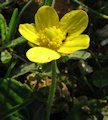 |
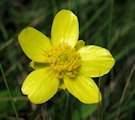 |
 |
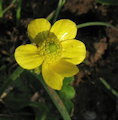 |
IMAGE: RNNBU-01 Photo of flower of Ranunculus bullatus which have the same structure of typical flowers of many species of the Buttercup family. |
IMAGE: RNNBU-02 Photo of flower composed of 5-10 yellow petals and a central ovary surmounted by many stamens. |
IMAGE: RNNBU-03 Close up photo of the yellow flower. The number of petals is not fixed, even between flowers of the same specimen and varies between 5-10. |
IMAGE: RNNBU-04 Photo of young flower taken in November. |
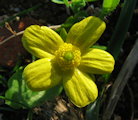 |
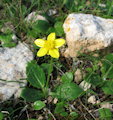 |
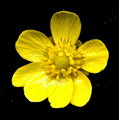 |
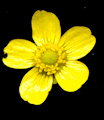 |
IMAGE: RNNBU-05 Close up photo of the actinomorphic flower. It has shining broad petals, sometimes in the form of a cup. The shining yellow feature gave the name of 'buttercup' for this family of plants, but note that several species of buttercups have white flowers. |
IMAGE: RNNBU-06 Photo of a flowering plant, very often with a solitary terminal flower per flowering stem. |
IMAGE: RNNBU-07 Scanned image of flower against a dark background. It consists of petals around a central receptacle with many simple pistils that are free from one another (= apocarpous). |
IMAGE: RNNBU-08 Scanned image of another flower. |
 |
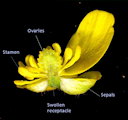 |
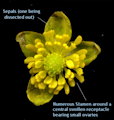 |
 |
IMAGE: RNNBU-09 Photo of buds of two young plants. |
IMAGE: RNNBU-10 Annotated scanned image of a transverse section of flower with most petals and some sepals dissected out. The single, free carpels lie on an elongated ovoid receptacle while a ring of stamens grows out from the base of the receptacle. The sepals are greenish-yellow and have a bowl shaped structure. |
IMAGE: RNNBU-11 Scanned image of a flower (top view) with all petals dissected to show the arrangement of stamens and cluster of pistils. |
IMAGE: RNNBU-12 Scanned image of petals characterised by being glossy (and unhairy), having a smooth outline, oval in shape, sometimes with a small indentation at the tip. Lower part of petal is darker yellow, veined and posses a tiny nectary at the very base. |
 |
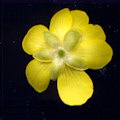 |
 |
 |
IMAGE: RNNBU-13 Scanned image of flower (lateral view) with some petals dissected out to show cluster of yellow stamens. |
IMAGE: RNNBU-14 Scanned image of flower (underside view) to show arrangement of the 5 oval, bowl shaped sepals. The number of petals may vary between 5 and 10, but the number of sepals is fixed to 5 in every flower. |
IMAGE: RNNBU-15 Photo of underside part of flower showing the sepals. |
IMAGE: RNNBU-16 Photo of flowering stem showing the long, soft, white hair all around. |
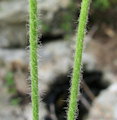 |
 |
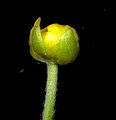 |
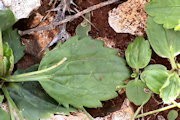 |
IMAGE: RNNBU-17 Photo showing the white hair covering the flowering stems. |
IMAGE: RNNBU-18 Photo of young plants with flowering buds. Flowering of this species can start from end October in Malta. |
IMAGE: RNNBU-19 Globular bud made of 5 similar sepals. |
IMAGE: RNNBU-20 Photo of leaves in situ. The large one at the left is a fully sized mature leaf, while 2 small leaves of a young plant are present on the right. Both have a serrated outline and in general an oval shape. |
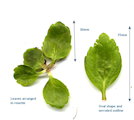 |
 |
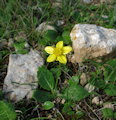 |
 |
IMAGE: RNNBU-21 Scanned image of leaves. Average length of a mature leaf is 35-40mm. |
IMAGE: RNNBU-22 Enlarged image of a typical leaf, glabrous with prominent pinnate venation, and a serrated outline. |
IMAGE: RNNBU-23 Photo of a specimen in situ. It consists of low-growing plant with few basal leaves lying on the ground and one to few flowering stalks with a terminal solitary yellow flower. |
IMAGE: RNNBU-24 Photo of plant. |
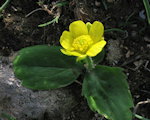 |
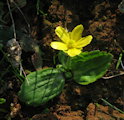 |
 |
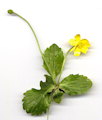 |
IMAGE: RNNBU-25 Photo of small plant. |
IMAGE: RNNBU-26 Photo of small plant. |
IMAGE: RNNBU-27 Photo of few specimens growing from a soil-filled pocket in karst rock of the Globgerina Limestone. |
IMAGE: RNNBU-28 Scanned image of entire plant. |
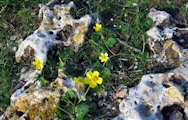 |
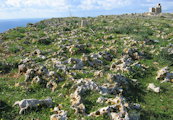 |
 |
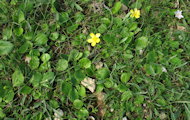 |
IMAGE: RNNBU-29 Photo of plant in shallow, damp soil found in gaps, pits and spaces between rocks. |
IMAGE: RNNBU-30 Photo of the typical habitat of Ranunculus bullatus in Malta - vegetated steppe and garigue. |
IMAGE: RNNBU-31 Photo of another related habitat of this species in Malta - shallow, damp, stoney soil lying on a rocky substratum. Very often the plants are found on the type of soil known as the red soil. |
IMAGE: RNNBU-32 Photo of an area with numerous specimens, which can get quite dense. |
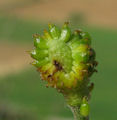 |
 |
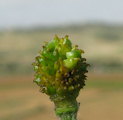 |
 |
IMAGE: RNNBU-33 Photo of fruit head in situ. Note that the receptacle is glabrous, often a feature used in taxonomical keys of the Genus Ranunculus. |
IMAGE: RNNBU-34 Photo of an unripe fruit-head with small, compact carpels developing into achenes. |
IMAGE: RNNBU-35 Photo of a fruit-head with some fertilised carpels developping into achenes, and other remained undeveloped, probably unfertilised. |
IMAGE: RNNBU-36 Scanned image of 4 fruit-heads with the ones on the right being the more mature. Each fruit cluster consists of single achenes closely packed on a common recaptacle. |
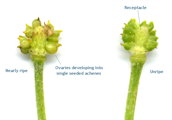 |
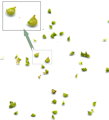 |
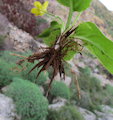 |
| IMAGE: RNNBU-37 A magnified scanned image of seed-head. The fertilised ovaries develop in a one-seeded achene without pappus and just fall off to the ground without any mechanical dispersion when ripe. The hooked tip on each achene might suggest aided seed dispersion by attachment to wandering animals. |
IMAGE: RNNBU-38 Image of seeds, including enlarged images of 2 typical seeds. They fall from the receptacle when they are green/light brown in colour. They are roundish with an eccentric rod-like structure by which the seeds were attached with the receptacle. One end of this rod-shaped structure was once the stigma+style. |
IMAGE: RNNBU-39 Photo of tuberous roots. |
IMAGE: RNNBU-40 |
|
| | |

